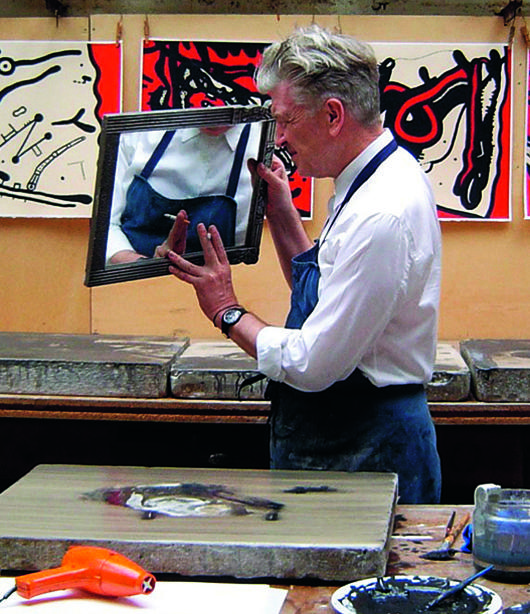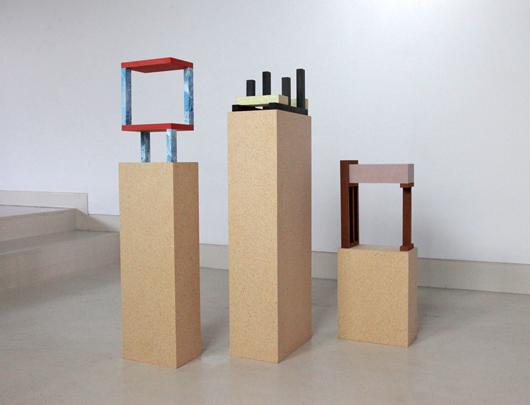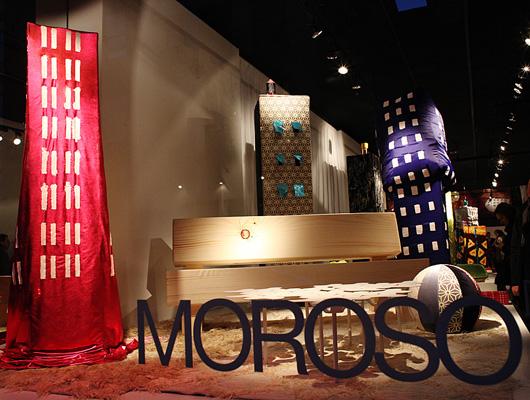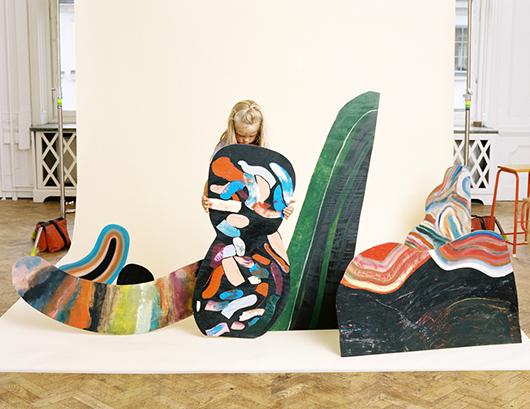
11.29.12
The Making of
Malin Gabriella Nordin’s Children’s Workshop
Malin Gabriella Nordin isn’t the type who’d be quick to align herself with an art movement — the 24-year-old prefers to stay as insulated as possible from outside influences, which is why she left her friends and family in Stockholm four years ago to attend art school in comparably tiny Bergen, Norway. But as it turns out, Nordin is something of a Surrealist, at least from where we’re standing: Everything about her process is geared towards connecting with her subconscious, from letting her sculptures develop intuitively and spontaneously to painting with quick-dry acrylics, eliminating any lag between her mind and the canvas. And then there’s her obsession with children. “My work has to do with reconstructing fragments from memories, and I’ve been working with my own childhood a lot,” she says. “I think of kids at that age as more free.” It’s that notion that led Dalí and Picasso to pay homage to the creativity of the pint-sized, and that led Nordin to make them the subject of her senior graduation project, inviting eleven children to participate in her artistic process.
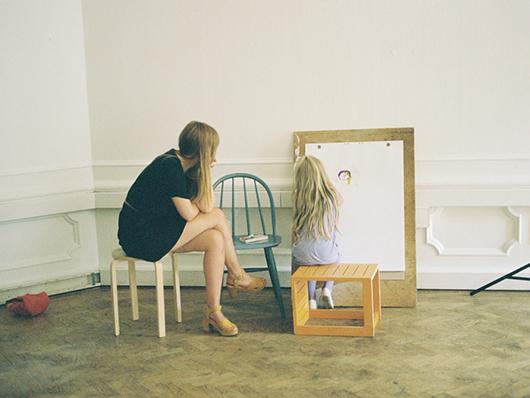 Nordin — pictured above with one of her subjects — asked friends and friends of friends to bring their kids to her studio for individual hourlong sessions in which she’d start by asking them what they thought of her painted sculptures. “I had to feel how the kid felt in order to figure out how to begin the conversation,” she says. “I didn’t want to lead them into anything, so I just said, ‘Can you see something in these shapes?’” Next, she invited them to create their own drawings, and to place them among her sculptures as they saw fit. Nordin described the experience in detail to Sight Unseen:
Nordin — pictured above with one of her subjects — asked friends and friends of friends to bring their kids to her studio for individual hourlong sessions in which she’d start by asking them what they thought of her painted sculptures. “I had to feel how the kid felt in order to figure out how to begin the conversation,” she says. “I didn’t want to lead them into anything, so I just said, ‘Can you see something in these shapes?’” Next, she invited them to create their own drawings, and to place them among her sculptures as they saw fit. Nordin described the experience in detail to Sight Unseen:
“I had this romantic picture of kids at that age; I thought they were really free and uncensored, with wild imaginations. But that picture wasn’t always true,” she says. “Many of them were afraid of saying the wrong thing, and didn’t dare to tell me what they thought. One boy, Buster, often went to museums with his mom and looked at art, and he was able to give me his thoughts and opinions. But you could tell the kids that just play on their iPhones, because they weren’t that open to interpreting my sculptures.
“Most of the kids thought my pieces were food, or everyday things, like bananas and sausages and a staircase, which was a little disappointing for me! (laughs) I thought their interpretations would be more crazy and abstract. But even the kids who didn’t want to tell me what they thought, or didn’t know, when I asked them if they thought the sculptures were standing in the wrong order, all but one got up and moved them around. They were so secure about it — they knew exactly where everything was supposed to go. Also, the sculptures are painted on one side and not the other, and I thought the kids would ask me why, but nobody did. I thought they would be more critical, or that someone would say, ‘This is ugly.’ I thought kids at that age were more honest, but maybe not. Maybe they were too polite.”
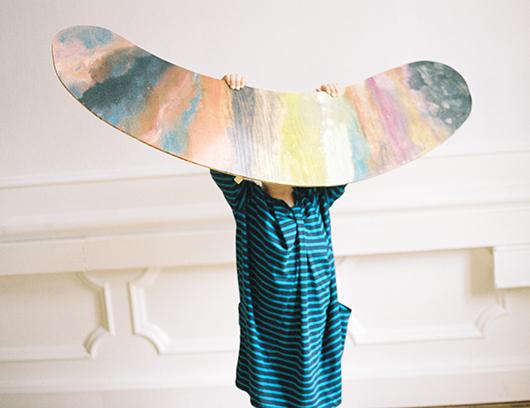 Regardless, Nordin recorded everything the children said about the sculptures, and having asked them to draw their own interpretations of her work, recorded what they said about those, too. The results are currently being exhibited in Bergen, and Nordin has since moved on to the second phase of the project: creating a new body of work in direct response to the childrens’ drawings and personalities. “Meeting with them was a way for me to move forward in my personal process by incorporating their thoughts and imagination, which has been really inspiring for me,” she says. “Everything started out with me wanting to work more freely and get rid of the self-censorship, allowing myself to make mistakes and to find new paths in the unpredictable, to completely trust the work — and myself. This project has made me much more open.” Once she’s done with the new pieces, she’ll assemble everything into a book, which she hopes to release in the summer, in time for a September solo show with her new gallery in Stockholm, NAU. But in the meantime, she gave Sight Unseen an exclusive sneak peek at the feedback she received during the workshop, of which we’re certain Dalí would be envious.
Regardless, Nordin recorded everything the children said about the sculptures, and having asked them to draw their own interpretations of her work, recorded what they said about those, too. The results are currently being exhibited in Bergen, and Nordin has since moved on to the second phase of the project: creating a new body of work in direct response to the childrens’ drawings and personalities. “Meeting with them was a way for me to move forward in my personal process by incorporating their thoughts and imagination, which has been really inspiring for me,” she says. “Everything started out with me wanting to work more freely and get rid of the self-censorship, allowing myself to make mistakes and to find new paths in the unpredictable, to completely trust the work — and myself. This project has made me much more open.” Once she’s done with the new pieces, she’ll assemble everything into a book, which she hopes to release in the summer, in time for a September solo show with her new gallery in Stockholm, NAU. But in the meantime, she gave Sight Unseen an exclusive sneak peek at the feedback she received during the workshop, of which we’re certain Dalí would be envious.
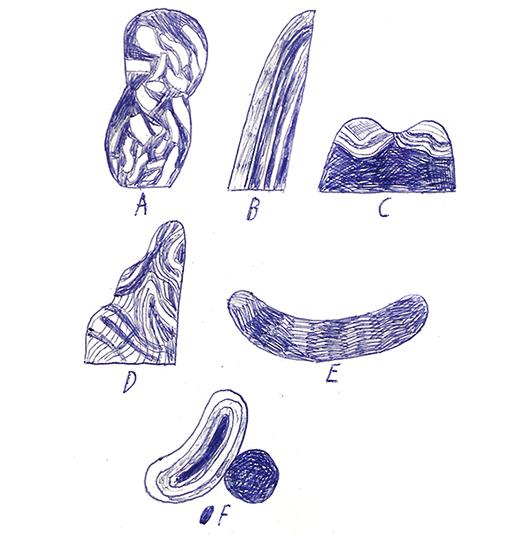 In their answers, the children refer to specific sculptures Nordin had set up in the studio for them to critique. Above is a labeled guide to the references they make below.
In their answers, the children refer to specific sculptures Nordin had set up in the studio for them to critique. Above is a labeled guide to the references they make below.
Buster, 3
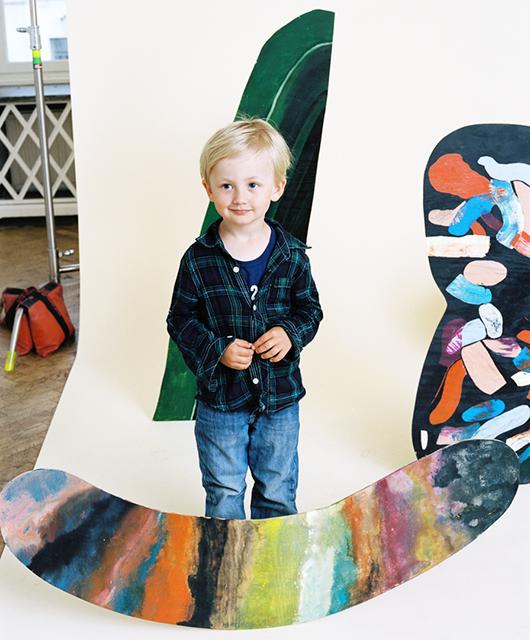 Do you think of anything when you see the shapes?
Do you think of anything when you see the shapes?
“This looks like a coconut ball and a sausage!” (shape F)
And what’s this? (shape A)
“Zebra skin! This is a mountain.” (shape D)
What is this? (shape C)
“A bag.”
What sort of bag?
“You can pack things in it… (Walks over to shape B) This is a cucumber.”
Is it bigger than the mountain?
“Yes.”
Can you climb the cucumber?
“Yes.”
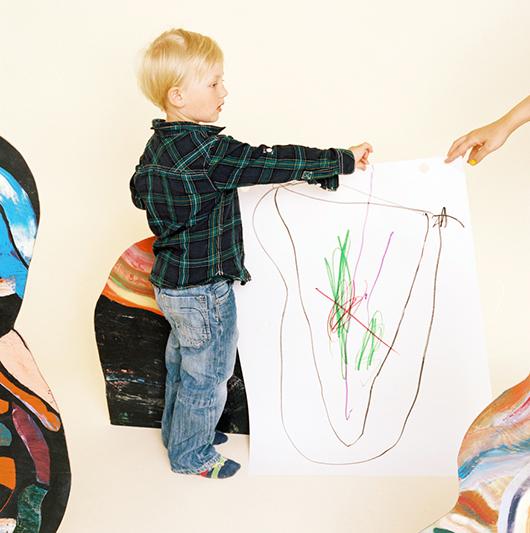 When do you use the bag then?
When do you use the bag then?
“When you’re traveling.”
And when do you eat the cucumber?
“You eat it on a fast plane.”
Ok, and the sausage?
“You eat it when you’re riding a, a… cargo motorcycle!”
The coconut ball, when do you eat it?
“When it’s a party.”
And the mountain?
“You climb it on Fridays.”
Only on Fridays? Not on Wednesdays?
“No.”
Why not?
“Because it’s slippery on Wednesdays.”
And the zebra skin? Can you wear it?
“Yes, but only on Christmas Eve!”
When you eat the sausage?
“Yes! You wear the bag in June, only… The coconut ball tastes like spaghetti.”
Felizia, 5
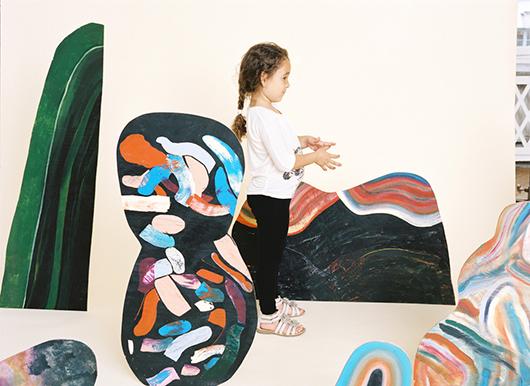 Do you think of anything when you see the shapes?
Do you think of anything when you see the shapes?
“I think of worms when I see this one.” (shape A)
What kind of worms?
“Beer worms.”
What are the beer worms doing?
“Living in the soil. This is a rainbow (shape D). And this shape looks like a cucumber (shape E). This is a happy mouth, and this round one is the moon (shape F).”
And this one? (shape C)
“A little creek.”
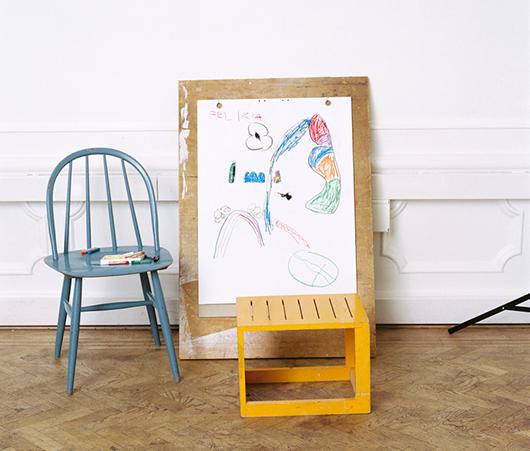 Do you want to draw your own shape that could go with my sculptures?
Do you want to draw your own shape that could go with my sculptures?
“Yes… This is a water slide. This is a rainbow, with clouds.”
Do you think you could tell me a story about these shapes?
“The story about.. the end of the rainbow! Two girls went out, found a rainbow, and the rainbow disappeared then.”
Where did the rainbow disappear to?
To the moon. So they went to the moon, and then they dug up a lot of gold.”
What happened when they found the rainbow?
“They went down the slide back to earth. Up here is the moon, and here they went down (edge of shape B). My rainbow is up here (top of shape B). They found the worms when they were digging gold here (shape A), and they swam over this creek (shape C) on earth when they were looking for the rainbow. And here they were climbing over a mountain on the moon (shape D). This one, this is a speaking mouth (shape F).”
Who’s talking?
“It’s the moon.”
What is he or she saying?
“It’s a she, and she says, ‘Seek underneath me.’ Then they discovered this one (shape E) and they took a rope and climbed over it and went to the other side of the moon.”
And when did they go down the slide you drew?
“When they came home from the moon, to celebrate.”
Matilda, 5
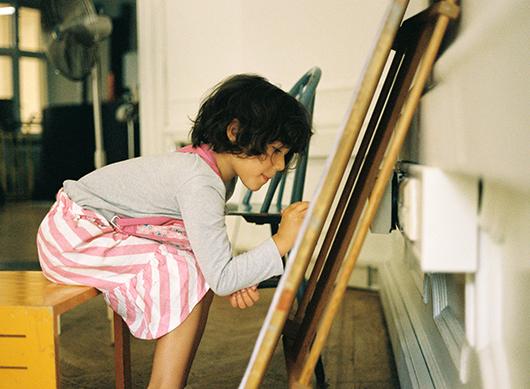 Do you think of anything when you see the shapes?
Do you think of anything when you see the shapes?
“This is grass, and this is a see-saw (shapes B and F). This is stones on top of each other (shape A). This is a sausage (shape E). This is a paper mountain, and this is water (shapes D and C).”
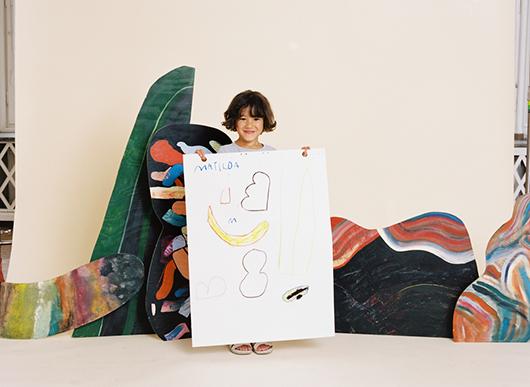 “(Draws shape E) At first this was a sausage, and now it’s a banana.”
“(Draws shape E) At first this was a sausage, and now it’s a banana.”
How did it become a banana?
“I did some magic. (Draws shape B) The grass has turned into a tree now. (Draws shape F) This is the see-saw.”
Who’s swimming in the water?
“A girl is swimming in the water, in the ocean.
How big is the ocean?
“The same size as the others. My little sister can’t drink all the water, it’s too much. (Continues to draw.) The girl is on the see-saw, and then she plays with the stones.”
What’s she doing with the stones?
“She makes her own stone man, here (shape A). Then she swims in the ocean (shape C) and climbs up the grass tree (shape B). And then she jumps down on the mountain (shape D), and the she climbs down and lands in… the banana (shape E)! And then she starts over again.”
The toadstool you drew before, where is that?
“I’ll make a new mushroom, a white mushroom! An invisible mushroom! One you can’t see.”
Is the invisible mushroom a good or bad mushroom?
“Good! If you eat it you can do magic!”
Is it the girl who turned the sausage into a banana?
“Yes, she eats the mushroom. She slides down on the mountain to the mushroom, then she eats and then she goes down into the banana. Eat and down!”
Queenie, 4
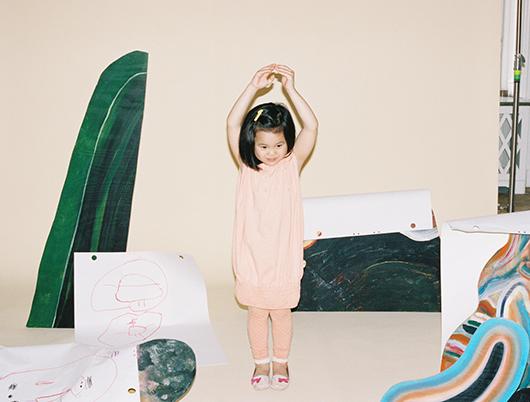 Do you think of anything when you see the shapes?
Do you think of anything when you see the shapes?
“It looks like an eight with candy in it (shape A). This looks like a banana, and this looks like a cucumber (shapes E and B). And this looks like a ball and a sausage (shape F). This is a staircase (shape D).”
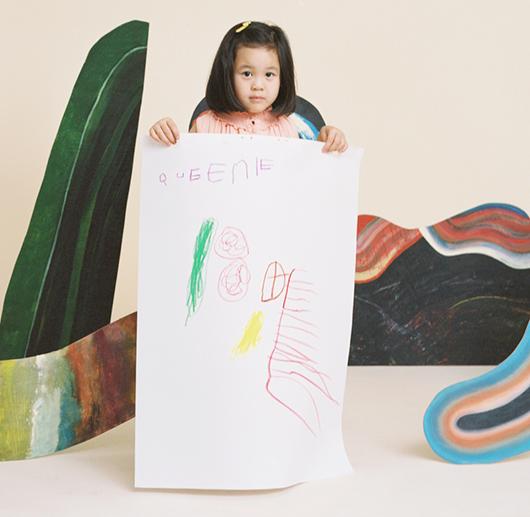 “(Drawing) This is a guy, an old man. He’s going to play with the ball. The eight is watching and eating candy. He loves candy. This is more balls — here’s mama-ball! I’m the little ball. Ball-mama, ball-Queenie, ball-papa! I’m going to draw a house where they can live. Here’s the window, and here’s another window you can open.”
“(Drawing) This is a guy, an old man. He’s going to play with the ball. The eight is watching and eating candy. He loves candy. This is more balls — here’s mama-ball! I’m the little ball. Ball-mama, ball-Queenie, ball-papa! I’m going to draw a house where they can live. Here’s the window, and here’s another window you can open.”
The guy you drew, where should he stand amongst the sculptures?
“He’s going to stand behind the cucumber and eat it, then he’s behind the eight and eating candy. Then he sleeps on the banana. The staircase leads to the house. The old man is named Henrik; it’s my little brother when he’s old. He’s lying down and sleeps; the banana is a bed. And this is a chair! (Counting the sculptures) One, two, three, four, five, six.. seven! But this is the eight? (Pouting at shape A)”
What kind of candy is inside the eight?
“Snake candy, ball candy, banana candy, rocks… and worms.”
ALL PHOTOS BY EMILIA BERGMARK-JIMÉNEZ
